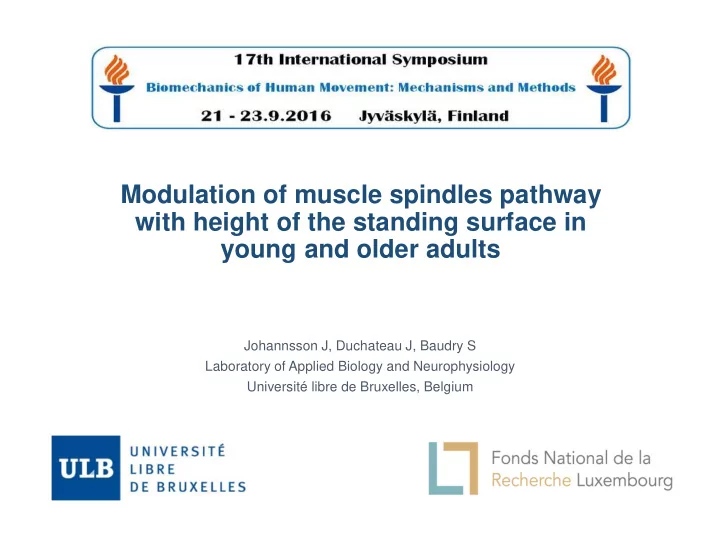

Modulation of muscle spindles pathway with height of the standing surface in young and older adults Johannsson J, Duchateau J, Baudry S Laboratory of Applied Biology and Neurophysiology Université libre de Bruxelles, Belgium
Postural control Integration of vestibular, visual and proprioceptive information in the central nervous system (Fransson et al. 2004) � Measure of Centre of Pressure (CoP) excursion: Point location of the vertical ground reaction force vector � Spectral analysis of CoP provides indirect informations of the sensory inputs controlling upright standing: • 0.2-0.5 Hz: Visual contribution (Mauritz et al. 1977; Singh et al. 2012) • 0.5-2 Hz: Vestibular contribution (Mauritz and Dietz 1980; Mauritz and Römmelt 1979) • 2-20 Hz: Proprioceptive contribution (Dietz et al. 1979; Dietz et al. 1980)
Spinal Modulation during postural control Hoffman (H) reflex Baudry et al. 2015
Hoffman (H) reflex is modulated depending on upright standing conditions � � H reflex when young adults stand at the edge of a platform at 1.6 m (Sibley et al. 2007) � restricting stepping response Ageing � Specific neural adjustments in balance control (Baudry 2016) � � fear of falling associated with stair negociation (Tiedemann et al. 2007) Investigate the modulation of the muscle spindles pathway at the top of a staircase in young and older adults
Methods • 10 young adults [24.7 (1.3) yrs] 10 elderly adults [72.2 (7.9) yrs] • Two experimental situations 0.7m Downstairs Upstairs
Variables of interest � H reflex recruitment curve: • 50% (H 50 ) of the maximal amplitude of H reflex in soleus ( expressed relative to M max ) • Slope of the input-output relation of H reflex calculated at H 50 � Electromyographic activities (EMG) • Soleus (SOL) • Gastrocnemius medialis (GM) • Tibialis anterior (TA) � CoP Parameters Frequency domain • Power spectral density (PSD) of CoP: 0.2-0.5 Hz; 0.5-2 Hz; 2-20 Hz Time domain • Path length (mm) • Sway area (mm²) • Mean Velocity (mm/s)
H-reflex amplitude decreases upstairs * 25 1.2 Young Older H reflex amplitude (%M max ) 1.0 20 Slope of H reflex 0.8 15 0.6 10 0.4 5 0.2 0 0.0 Down Up Down Up Situation main effect: p=0.06 Age main effect: p=0.02 Age main effect: p=0.06 Situation x Age: p>0.05 Situation x Age: p>0.05
No change in SOL and GM EMG but change in TA EMG Soleus: Tibialis anterior: Age main effect: p> 0.05 Age main effect: p> 0.05 Young Situation x Age: p>0.05 Situation x Age: p>0.05 Older * 0.04 0.025 0.020 0.03 EMG-SOL (mV) EMG-TA (mV) 0.015 0.02 0.010 0.01 0.005 0.00 0.000 Down Up Down Up No relation with H reflex amplitude (r²=0.01, p>0.05)
Opposite shift in low- and high frequency band Visual modulation: 0.2-0.5 Hz Proprioceptive modulation: 2-20 Hz Age main effect: p> 0.05 Age main effect: p> 0.05 Situation x Age: p>0.05 Situation x Age: p>0.05 Young Older * 100 20 * 18 16 75 14 PSD 0.2-0.5 Hz PSD 2-20 Hz 12 50 10 8 6 25 4 2 0 0 Down Up Down Up Vestibular modulation: 0.5-2 Hz: No modulation
Greater CoP excursions upstairs * 500 Young Older 400 CoP Sway area (mm 2 ) CoP mean velocity: Situation main effect: p= 0.002 300 Age main effect: p=0.02 Situation x Age: p>0.05 200 CoP Path length: 100 Situation main effect: p= 0.005 Age main effect: p=0.04 Situation x Age: p>0.05 0 Down Up
Increase in CoP excursions � Increase in CoP excursions when standing upstairs In contrast with previous literature (Adkin et al. 2000; Davis et al. 2009) � Increase TA EMG activity: change of posture (backward shift) (Carpenter et al 1999) � Changes in CoP parameters depends on the height of the surface (Davis et al. 2009) � Possibility to use stepping strategy
Decrease in the proprioceptive contribution � Decrease in H-reflex amplitude and slope upstairs (Sibley et al 2007) • Increase in TA EMG but no relation between H reflex and TA EMG � Likely not reciprocal inhibition: inhibition of the antagonist by the activation of the agonist (Johannsson et al. 2015) • No changes in plantar flexors EMG and no relation between H reflex and plantar flexors EMG � Likely not due to a change in the excitability of the motor neurones pool (Matthews 1986) � Role of presynaptic inhibition: inhibition of the Ia afferent input onto the motor neuron pool (Rudomin and Schmidt 1999) � Situation-related modulation of H-reflex pathway � Reduce the risk of unexpected reflex activity that may impair balance control (Diener et al. 1983)
Decrease in the proprioceptive contribution � Increase in PSD in 0.2-0.5 Hz frequency band � Increased contribution of visual information � Decrease in PSD in 2-20 Hz frequency band � Decreased contribution of proprioceptive information � Reweighting of the sensory sources when standing upstairs: Shift to greater reliance on visual inputs to control upright standing at the top of the stairs
Younger = Older � Similar H reflex pathway modulation • Greater from a seated to upright standing position (Baudry et al. 2015) • Lesser during contraction tasks (Chen et al. 2015; Holmes et al. 2015) � Task-dependent modulation � Healthy and active elderly adults : • Berg scale > 45 • Short Physical Performance Battery (8-12) � Daily live situation � Increase risk of fall in staircase when < 4 steps (Jackson and Cohen, 1995)
Conclusion Decrease in H-reflex amplitude with a reduced contribution of proprioceptive inputs and a greater dependance of visual inputs when standing upstairs in young and older adults � Reweighting of sensory inputs when standing at the top of a staircase � Healthy older adults preserved their ability to adjust postural control to environmental demand jjohanns@ulb.ac.be
Thank you for your attention! jjohanns@ulb.ac.be
Recommend
More recommend